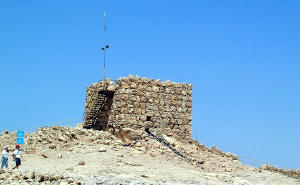 |
Masada |
| Masada is a free-standing, sheer-sided
plateau high above the Dead Sea. It will be forever famous as the site
of a glorious rearguard action by Jewish Zealots after the fall of
Jerusalem in around AD70.
967 men, women and children took refuge in the fortress and were besieged for a long period, reputed to be several years. The Romans built a ramp from the West and eventually brought in siege engines. At this point, the Zealots killed each other and set fire to their homes and possessions. The ramp has survived to the present time. |
|
| We arrived at the base of Masada and almost
immediately took the new cable car up to the top of the plateau. The
view showed the steep side of the valley between Masada and the main
cliff wall of the Rift Valley.
Others, not from our group were clearly intent on doing Masada the hard way, taking the zig-zag Snake Path down from the top, |
|
| Looking down from the top of the cable car,
there was an excellent view of the buildings at the base area, including
a youth hostel and in particular the archeological excavations of an old
Roman camp.
The view from inside the walls of the citadel shows the two sections of the Dead Sea well below. |
|
| There has been a cable car at Masada for some
years. A new one was opened in 1999 that reaches almost up to the
plateau level.
The old one which is still in place reached the Snake Path some distance from the top. |
|
| The new cable car reaches a platform built out
from the rock and a walkway, no-where near as precarious as it looks, up
to the Snake Path Gate.
Out tour started with Hermann taking advantage of the shade to start to explain the history of Masada. |
|
| There seem to be a large number of this particular kind of bird around the Dead Sea and Masada. This one was on the wall near the top of the cable car. There were many others swooping around the shaded picnic area. | |
| The Byzantine Church dates back to the 5th century. There remains parts of the walls and a mosaic floor. | |
| The synagogue at Masada is the oldest found
anywhere in the world and the only one dating back to the time of the
Temple in Jerusalem. It is still considered KOSHER and used for some special events.
Masada was extensively excavated in the 1960s. Some areas are being rebuilt, using pieces of stone found nearby. Everything above the black line on the walls has been rebuilt. We were able to take advantage of the shaded seating while listening to Hermann continuing the history of Masada. |
|
| The water cistern is one of 13 that enabled people to live on this citadel in such a barren place. Rain water was collected and overall Masada is thought to have had about four years supply of water. | |
| There are three Roman camps that have been
excavated. The most impressive is on top of the cliffs, North East of
Masada.
These photographs show clearly the arid landscape of the Megev desert and the high sandstone cliffs on the Eastern side of the Rift Valley. |
|
| In June 1999, the temperature at Masada
reached 54° Celsius. On the day we visited it was just over 30°, and
in the sun that was almost too much to bear.
Our guide was very keen to provide us with every last detail and on some occasions, the guided tour became more of an endurance test. This solitary tree outside of the bath house provided a welcome area of shade for some people at least. |
|
| There are several places which offer magnificent views across the Dead Sea. The photo on the left is looking to the North. The photo on the right looking across towards Jordan shows how the water is so low that what was once a single body of water is now split into two. | |
| One of the highlights of Masada is Herod's
bath house. There is sufficient of the original mosaics and structure
remaining to give a very good impression of what it must have been like.
The picture at the top left shows a traditional Jewish running water bath for ritual cleansing. The two pictures at the bottom show how a false floor was used to allow wood to be burned and create a sauna. One of the less desirable features is the hole in the wall through which small children were sent to clear ash and replenish the wood. |
|
| Herod's Palace at the Northern tip of the plateau was built on three levels with a commanding view over the valley floor. | |
| Perhaps not quite as old as some of the other things, the cement mixer shows that restoration continues. | |
| The reward for finishing the tour was a ride
back down the cable car and time for a welcome drink at the bottom
before getting back on the coach.
The various photos of the cable car, give some impression of the steepness of the sides of the outcrop. |
|
| The alternative route to the summit of Masada was visible below the cable car. The snake path was originally the only path to the top. | |
| The bus waiting at the bottom. |
Last updated: May 20, 2000